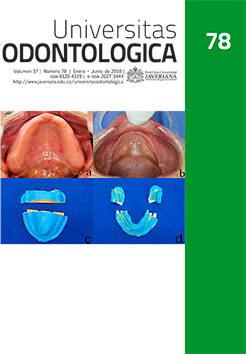Abstract
Background: Odontogenic cysts and tumors (OCTs) are an important group of oral pathologies. There are no epidemiological data of the frequency of these lesions among Nicaraguans. Purpose: To establish the relative frequency of OCTs in Nicaraguan population. Methods: This was a retrospective study in which excisional biopsy records of regional hospital pathology departments from the cities of León, Managua, Estelí, Matagalpa, and Jinotega, obtained between 2010 and 2016, were analyzed. The pathologies were classified using the World Health Organization 2017 guidelines. Data analysis was descriptive through relative frequencies. Results: There were 109 OCT cases (0.8 %) out of 13,102 reports reviewed. Distribution by sex was 50.9 % men and 49.9 % women, mainly in the 11-to-30-year age range. The most frequent cyst was dentigerous cyst (69.5 %) and the most common odontogenic tumor was ameloblastoma (50 %), predominantly in the jaw. Conclusion: This study provides epidemiological information on OCTs from five Nicaraguan cities. These data are important to identify groups at risk and possible associated factors, and to implement differential diagnostic and adequate treatment systems.
García-Rubio A, Bujaldón-Daza AL, Rodríguez-Archilla A. Lesiones periapicales. Diagnóstico y tratamiento. Av Odontoestomatol. 2015; 31(1): 31-42.
Villasis- Sarmiento L, Portilla-Robertson J, Meléndez-Ocampo A, Gaitán-Cepeda LA, Leyva-Huerta ER . Prevalence and distribution of odon . Prevalence and distribution of odontogenic cysts in a Mexican sample. A 753 cases study. J Clin Exp Dent. 2017; 9(4): e531-e538.
Contreras D, Dellán A, Granadillo K, Tinoco P, Salazar N, Villarroel-Dorrego M. Estudio clínico transversal de tumores odontogénicos: análisis clínico patológico de 450 casos. Acta Bioclínica. 2013; 3(5): 98-115.
Mosqueda-Taylor A, Meneses-García A, Ruíz-Godoy-Rivera LM, Suárez-Roa ML, Luna-Ortiz K. Tumores odontogénicos malignos. Estudio retrospectivo y colaborativo de 7 casos. Med Oral. 2003; 8: 110-21.
Lima-Verde-Osterne R, Turatti E, Cordeiro-Teixeira R, Barroso-Cavalcante R. The relative frequency of odontogenic tumors: A study of 376 cases in a Brazilian population. Med Oral Patol Oral Cir Bucal. 2017; 22(2): e193.
Fungi Monetti M. Revisión analítica de los quistes odontogénicos: Archivo de la Cátedra de Anatomía Patológica Facultad de Odontología UdelaR. Odontoestomatol. 2011; 13(18): 56-65.
Castillo BA, Dávila EM. Frecuencia de quistes y tumores de origen odontogénico en los Hospitales "Oscar Danilo Rosales". León. y "Manolo Morales". Managua. 1980-1988. León, Nicaragua: Universidad Nacional Autónoma de Nicaragua León; 1993.
Instituto Nacional de Información de Desarrollo (INIDE). Anuario estadístico 2012. Managua: Nicaragua: INIDA; 2012. Dosponible en: http://www.inide.gob.ni/estadisticas/Cifras%20municipales%20a%C3%B1o%202012%20INIDE.pdf.
Philipsen HP, Reichard PA. Classification of odontogenic tumours. A historical review. J Oral Pathol Med. 2006; 35(9): 525-9.
Buchner A, Merrell PW, Carpenter WM. Relative frequency of central odontogenic tumors: a study of 1,088 cases from Northern California and comparison to studies from other parts of the world. J Oral maxillofac Surg. 2006; 64(9): 1343-52.
Raj A, Ramesh G, Nagarajappa R, Pandey A, Raj A. Prevalence of odontogenic lesions among the Kanpur population: an institutional study. J Exp Ther Oncol. 2017; 12(1): 35-42.
Sekerci AE, Nazlım S, Etoz M, Denız K, Yasa Y. Odontogenic tumors: a collaborative study of 218 cases diagnosed over 12 years and comprehensive review of the literature. Med Oral Patol Oral Cir Bucal. 2015; 20(1): e34-44.
Goteti SH. Odontogenic tumors: A review of 675 cases in Eastern Libya. Niger J Surg. 2016; 22(1): 37-40.
Neville BW, Damm DD, Chi AC, Allen CM. Oral and maxillofacial pathology. St Louis, Missouri: Elsevier; 2015.
Cawson RA, Cawson E, Odell E. Cawson fundamentos de medicina y patología oral: Barcelona, España: Elsevier; 2009.
Ceccotti S, Forteza C, Luberti F. El diagnóstico en clínica estomatológica. Buenos Aires, Argenitna: Panamericana; 2007.
Reichart P, Philipsen H, Sonner S. Ameloblastoma: biological profile of 3677 cases. Europ J Cancer B Oral Oncol. 1995; 31B(2): 86-99.
Ledesma‐Montes C, Mosqueda‐Taylor A, Carlos‐Bregni R, De León ER, Palma‐Guzmán J, Páez‐Valencia C, Meneses-García A. Ameloblastomas: a regional Latin‐American multicentric study. Oral Dis. 2007; 13(3): 303-7.
This journal is registered under a Creative Commons Attribution 4.0 International Public License. Thus, this work may be reproduced, distributed, and publicly shared in digital format, as long as the names of the authors and Pontificia Universidad Javeriana are acknowledged. Others are allowed to quote, adapt, transform, auto-archive, republish, and create based on this material, for any purpose (even commercial ones), provided the authorship is duly acknowledged, a link to the original work is provided, and it is specified if changes have been made. Pontificia Universidad Javeriana does not hold the rights of published works and the authors are solely responsible for the contents of their works; they keep the moral, intellectual, privacy, and publicity rights.
Approving the intervention of the work (review, copy-editing, translation, layout) and the following outreach, are granted through an use license and not through an assignment of rights. This means the journal and Pontificia Universidad Javeriana cannot be held responsible for any ethical malpractice by the authors. As a consequence of the protection granted by the use license, the journal is not required to publish recantations or modify information already published, unless the errata stems from the editorial management process. Publishing contents in this journal does not generate royalties for contributors.



